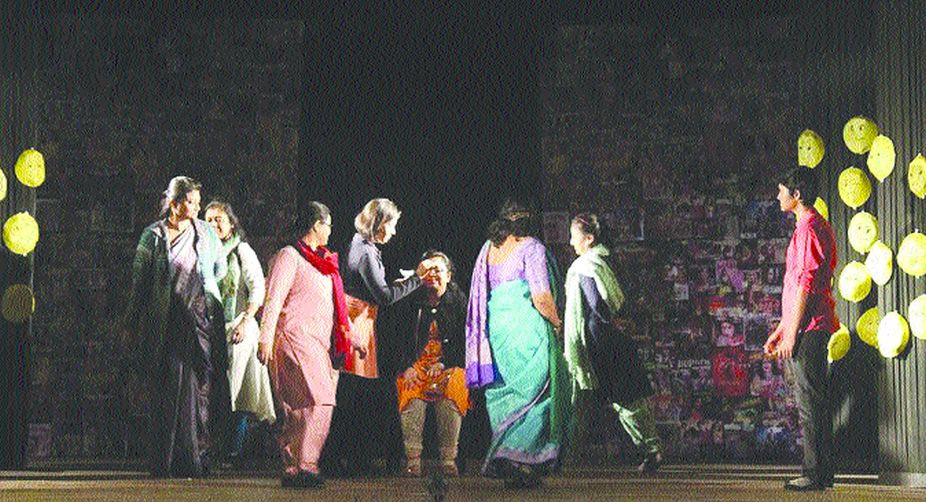Theatre is not only a form of entertainment but an agent of meaningful change and a tool of protest against social evils, injustices, discrimination and malpractices.
Following this maxim as its main guiding principle, Delhi-based playgroup Shapno Ekhon recently staged two thought-provoking pieces — Galpo Shesher Pore and Manohar Kahaniya — at Kolkata’s Jogesh Mime Academy on 28 and 29 November. The director Shomik Ray (also accredited with playwright and design responsibilities) firmly believes that theatre has a social obligation to stimulate the collective consciousness with progressive and insightful presentations. His nine-year-old troupe boasts of skilled and naturally gifted actors.
A bunch of students from Foundation was also roped in on short notice to add realism to the piece, which is often truly lent by raw, amateur, non-actors.
Theatre practitioners have long been exploring the experimental space in the dramatic domain. And this outfit’s initiative is no different. Going beyond the periphery of proscenium on the first day, the play instantly converted itself into half site-specific and utilised the auditorium gallery with the cast strolling around and encircling the seated spectators who got a 360 degree view of the play. Also two characters portrayed as rural raconteurs appeared from the left wings adjoining the enclosed four-walled stage area to narrate simple sweet folklore and depict an idyllic village scene. But life is not just a bed of roses but a path full of thorns too. After delineating a peaceful picture, the pastoral storytellers exposed a dark tale of torture and ignominy of village belles and wives at the hands of dacoits and looters who again attacked from the dimmed gallery end. They not only plundered wealth but outraged the modesty of household women. The reigning king and the local legal system ordained that the best way to safeguard the family’s respect and its women’s honour is to wisely implement female foeticide. So kill the girl child before birth ~ nipping the flower in the bud itself.
Based on the 16th December 2012 brutal gang-rape of Jyoti ‘Nirbhaya’ Singh in a moving bus at Delhi, Galpo Shesher Pore tried to hammer the fact into our heads that violence and atrocities against women — be it one’s daughter, sister, mother, friend, colleague continues unabated and unabashedly. Who or what is responsible for these heinous crimes and what can be done to redress this sickening act, occurring day in day out, were some of the valid questions thrown open at a forum at the end of the second day’s performance.
The other play, Manohar Kahaniya was on the Park Street rape case, focussing on resolute survivor Suzette Jordan through a blow by blow account in detail. Unfortunately, she succumbed to malignant encephalitis in March 2015 after enduring a fusillade of slurs on her character and a bitter court battle to obtain justice. But not before she soared from the ashes like a Phoenix to strongly emerge an anti-rape campaigner. Social activist Santosree Chowdhury of Bodhi Tree stood as a tall pillar of support to put Jordan through a healing programme that enabled her to come out of the trauma.
Spontaneous responses came from the captivated audiences who stressed on altering one’s attitude, stopping gender biases, sensitising the apathetic cops and increasing police vigilance, teaching the boys to treat women as human beings first and with respect, spreading general awareness and education, training the art of self-defence, etc. Finally, all chorused to take a solemn oath: “No not again, not anymore”. A white canvas was mounted up inside the hall for viewers to scribble their heartfelt comments on it before leaving the venue.
The female protagonist in the first message-driven play is a theatre actor who couldn’t concentrate on her rehearsals as she was extremely disturbed mentally by the Nirbhaya incident.
She constantly felt the fetters on her feet and a noose in her neck, fetters by the male members of patriarchy. Consumed by the barrage of news headlines both from the electronic and print media, she ran from Safdarjung hospital to the India Gate to raise her voice and be with the victim in spirit. She inspires her co-artistes, especially the men to rally behind this cause and lend their support and solidarity to the same. In the end, all light incense sticks and pledge a promise to make a difference to the regressive situation.
The second play began on an interactive mode right from the start. It asked for audience-participation by calling people to volunteer in an interesting game called ‘hot seat’. A bevy of ladies went onstage for a ‘musical chair’ like game and a handful few got a chance to sit on the chair placed centrestage facing the audience. Music was generated simulating the ticking of a clock and ending with an alarm bell. Whoever sat on the chair after spinning around it as soon as the music stopped was marked with a bindi. They all joined the game willingly. But what if they were compelled to sit on that dreadful chair like a rape victim which according to NCPR’s (National Commission for Protection of Child Rights) data collected in 2015, in India, a rape happens after every 15 minutes? Only 30 per cent of the crimes get reported. Child and women’s rights activist Sraboni Sarkar read out the published information prior to the first day’s rendition.
The art direction of the second play was deeply meaningful with emoticons pinned up on both sides of the stage. The masks were not mere facial expressions but public reactions to an oppressed victim under the spotlight. Gradually one by one, the emojis started coming off. The background had dissected partitions plastered with photographs and news coverage of violence against women from every corner of the country. Well, check the list for yourself ~ right from Delhi, Mumbai, Kolkata to Kamduni, Barasat, Bengaluru, Badayun, Bundel Shahar…it is limitless.
The mid-portion was utilised by the performers for enactment. While the performance was on, some members of the cast pasted coherent posters on the partition walls. This kind of theatrical experience no doubt involves a thorough mental exercise for whoever watches it.
Ironically, the play never ceases to lose relevance in the contemporary world. The stories could have been on anybody. So before these cases turn into permanent statistical data stored in files and fade from our memory, let’s bring about a change.











